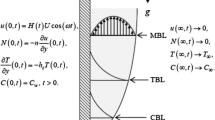Abstract
The flow of a dipolar fluid between two parallel plates with and without heat transfer is studied. The following cases are discussed:
-
(i)
Isothermal flow due to the relative motion of the plates,
-
(ii)
Isothermal flow due to a constant pressure gradient with the plates at rest,
-
(iii)
Nonisothermal flow with linearly varying plate temperatures.
Case (ii) is of particular interest to the experimentalists as it shows the effect of the material constants even when there are no externally applied dipolar tractions on the plates.
Similar content being viewed by others
Abbreviations
- A :
-
constant axial temperature gradient
- c v :
-
specific heat at constant volume
- D/Dt :
-
material derivative
- d ij :
-
components of rate of deformation tensor
- E :
-
Eckert number \(\frac{{h^4 \left( {\frac{{\partial p}}{{\partial x}}} \right)^2 }}{{c_v \mu ^2 T_0 }}\)
- F ij :
-
components of dipolar body forces per unit mass
- 2h :
-
distance between the plates
- h 1, h 2, h 3, d :
-
material constants
- l 2 :
-
h 1+h 3/μ
- M 1, M 2 :
-
externally applied dipolar tractions at the boundaries y=−h and y=h respectively
- \(\overline {M_1 }\) :
-
\(\frac{{M_1 }}{{h\frac{{\partial p}}{{\partial x}}}}\)
- \(\overline {M_2 }\) :
-
\(\frac{{M_2 }}{{h\frac{{\partial p}}{{\partial x}}}}\)
- \(\overline M\) :
-
\(\overline M _1 + \overline M _2\)
- N 2 :
-
h 2/μh 2
- N 1 :
-
M 1/μU
- N 2 :
-
M 2/μU
- n i :
-
components of unit normal vector
- P :
-
Prandtl number μc v /β
- p :
-
hydrostatic pressure
- q i :
-
heat flux components
- Q :
-
volume rate of flow
- R :
-
\(\frac{{{}_\gamma A}}{{h^2 \frac{{\partial p}}{{\partial x}}}}\)
- S :
-
\(\frac{{A\rho h^4 \frac{{\partial p}}{{\partial x}}}}{{\mu ^2 T_0 }}\)
- T :
-
temperature
- T 0 :
-
plate temperature at the origin
- \(\bar T\) :
-
T − T w /T 0
- T w :
-
temperature of the plates
- \(\overline T _m\) :
-
maximum temperature
- T ij :
-
components of dipolar tractions
- t ij :
-
components of stress tensor
- U :
-
uniform velocity
- u :
-
velocity along x-axis
- ū :
-
\(\frac{{\mu u}}{{h^2 \frac{{\partial p}}{{\partial x}}}}\)
- u*:
-
u/U
- v i :
-
components of velocity vector
- x :
-
coordinate along the direction of flow
- x i :
-
coordinate directions
- y :
-
transverse coordinate
- y:
-
y/h
- z :
-
coordinate direction perpendicular to xy-plane.
- α :
-
material constant
- β :
-
thermal conductivity
- γ :
-
material constant
- δ ij :
-
Kronecker delta
- μ :
-
fluid viscosity
- ρ :
-
fluid density
- λ :
-
l/h
- φ, Χ i :
-
arbitrary functions related to the hydrostatic pressure by (1.2)
- σ ij :
-
components of non-symmetric monopolar stress tensor
- ∑ ijk :
-
components of dipolar stresses
Reference
Bleustein, J. L. and A. E. Green, Int. J. Engng. Sci. 5 (1967) 323.
Author information
Authors and Affiliations
Rights and permissions
About this article
Cite this article
Katyal, K.N. Flow of a dipolar fluid between parallel plates. Appl. Sci. Res. 23, 281–294 (1971). https://doi.org/10.1007/BF00413204
Received:
Revised:
Issue Date:
DOI: https://doi.org/10.1007/BF00413204




